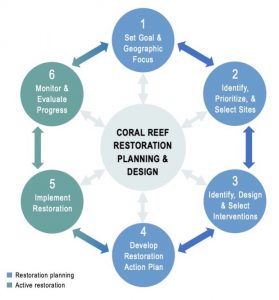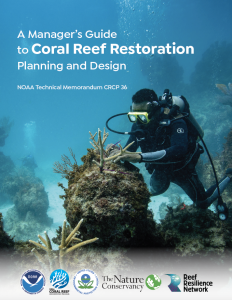Project Planning
Resource managers are exploring how to use active restoration interventions to mitigate reef degradation and promote recovery and resilience.
The urgent motivation to sustain coral reefs has fueled momentum to restore and rebuild reefs, with increasing numbers of projects, research studies, and investments. However, coral reef restoration as a field is still in its infancy, with many projects and techniques remaining small-scale and experimental. As managers seek to invest in restoration activities, careful planning is required to improve the chances that restoration will be successful. The needed planning includes working with local experts, stakeholders, and decision-makers to determine how, when, and where restoration will be conducted, and how it can complement - rather than take away from – existing coral reef conservation and management strategies.
A Manager’s Guide to Coral Reef Restoration Planning and Design supports the needs of reef managers seeking to begin restoration or assess their current restoration program. The Guide is aimed at reef resource managers and conservationists, along with everyone who plans, implements, and monitors restoration activities.

Six-step planning cycle presented in the Guide. Each step is described within a section of the Guide. The planning cycle is iterative, hence the circular nature of the process and double-sided arrows between the steps. The cycle includes multiple entry points that can be used depending on where Guide users are in the planning process in their area.
Through a six-step, adaptive management planning process, the Guide helps managers gather relevant data, ask critical questions, and have important conversations about restoration in their location. The process set out in the Guide leads to the creation of a Restoration Action Plan. Hallmarks of the process include the iterative nature of the planning cycle and ways to consider climate change, such that we learn and improve restoration efforts that can also meet long-term goals in a warming world. The first four steps of the Guide’s planning cycle focus on goal-based planning and design of restoration interventions. The final two steps discuss considerations for full-scale implementation and long-term monitoring.
Engaging relevant and various stakeholders (e.g., Traditional Owners and local Indigenous community groups, decision makers, private sector) is an essential part of the planning and design process of coral reef restoration efforts and should be integrated in each step. Such engagement is crucial to build long-term support from the public, empower partnerships with diverse sectors and stakeholders, avoid potential conflicts, and link conservation actions to economic goals. ref
The Guide includes two Appendices and other tools and materials that can be used assist readers in developing a Restoration Action Plan, including:
- Workbook (.doc) – helps document the process, information, and decisions made during Steps 1-4 of the planning cycle.
- Action Plan Template (.doc) – can be used to shape a Restoration Action Plan using information summarized when completing the Workbook.
- Step 2 Tutorial and Complete Example (.xlsx) – presents a worked example of how to compile, sort, and analyze data to assist in selecting sites for restoration.
- Step 3 Intervention Criteria Evaluation Tool (.xlsx) – helps evaluate and then select restoration intervention options.
- Case Study Example & Workbook for Coastal Protection Goal (.pdf) - provides a full workbook example detailing the restoration planning for coastal protection.
Citation: Shaver E C, Courtney C A, West J M, Maynard J, Hein M, Wagner C, Philibotte J, MacGowan P, McLeod I, Boström-Einarsson L, Bucchianeri K, Johnston L, Koss J. 2020. A Manager’s Guide to Coral Reef Restoration Planning and Design. NOAA Coral Reef Conservation Program. NOAA Technical Memorandum CRCP 36, 120 pp. https://doi.org/10.25923/vht9-tv39.
Explore the online course:

